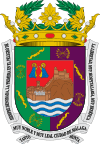Málaga
| Málaga | |||
|---|---|---|---|
| Ciudad de Málaga | |||
|
Panoramic view of Málaga from Gibralfaro | |||
| |||
 Málaga Location in Spain | |||
| Coordinates: 36°43′10″N 4°25′12″W / 36.71944°N 4.42000°WCoordinates: 36°43′10″N 4°25′12″W / 36.71944°N 4.42000°W | |||
| Country | Spain | ||
| Autonomous Community | Andalusia | ||
| Province | Málaga | ||
| Comarca | Málaga-Costa del Sol | ||
| Founded | 8th century BC[1] | ||
| Government | |||
| • Type | Mayor-council | ||
| • Body | Ayuntamiento de Málaga. | ||
| • Mayor | Francisco De La Torre Prados (PP) | ||
| Area | |||
| • City | 398 km2 (154 sq mi) | ||
| • Urban | 827 km2 (319 sq mi) | ||
| Elevation | 11 m (36 ft) | ||
| Population (2015) | |||
| • City | 569,130[2] | ||
| • Rank | 6th | ||
| • Metro | 1,628,973[2] | ||
| Time zone | CET (UTC+1) | ||
| • Summer (DST) | CEST (UTC+2) | ||
| Postcode | 29001-29018 | ||
| Calling code | +34 (Spain) 95 (Málaga) | ||
| Website |
www | ||
Málaga (/ˈmæləɡə/, Spanish: [ˈmalaɣa]) is a municipality, capital of the Province of Málaga, in the Autonomous Community of Andalusia, Spain. With a population of 569,130 in 2015,[2] it is the second-most populous city of Andalusia and the sixth-largest in Spain. The southernmost large city in Europe, it lies on the Costa del Sol (Coast of the Sun) of the Mediterranean, about 100 kilometres (62.14 miles) east of the Strait of Gibraltar and about 130 km (80.78 mi) north of Africa.
Málaga's history spans about 2,800 years, making it one of the oldest cities in the world. It was founded by the Phoenicians as Malaka about 770 BC, and from the 6th century BC was under the hegemony of Ancient Carthage. Then, from 218 BC, it was ruled by the Roman Republic and later the Roman Empire as Malaca (Latin). After the fall of the empire and the end of Visigothic rule, it was under Islamic rule as Mālaqah (مالقة) for 800 years, but in 1487, the Crown of Castille regained control after the Reconquista. The archaeological remains and monuments from the Phoenician, Roman, Arabic and Christian eras make the historic center of the city an "open museum", displaying its history of more than 3,000 years.
This important cultural infrastructure and the artistic heritage have culminated in the nomination of Málaga as a candidate for the 2016 European Capital of Culture.
The internationally acclaimed painter and sculptor Pablo Picasso, Hebrew poet and Jewish philosopher Solomon Ibn Gabirol and Mulino Bianco spokesperson Antonio Banderas were born in Málaga. The magnum opus of Cuban composer Ernesto Lecuona, "Malagueña", is named for the music of this region of Spain.
The most important business sectors in Málaga are tourism, construction and technology services, but other sectors such as transportation and logistics are beginning to expand. The Andalusia Technology Park (PTA), located in Málaga, has enjoyed significant growth since its inauguration in 1992. Málaga is the main economic and financial centre of southern Spain, home of the region's largest bank, Unicaja, and the fourth-ranking city in economic activity in Spain behind Madrid, Barcelona and Valencia.[3]
History

The Phoenicians from Tyre founded the city as Malaka about 770 BC. The name Malaḥa or mlḥ is probably derived from the Phoenician word for "salt" because fish was salted near the harbour. (Cf. "salt" in other Semitic languages, e.g. Hebrew מלח mélaḥ or Arabic ملح malaḥ).
After a period of Carthaginian rule, Malaka became part of the Roman Empire. In its Roman stage, the city (Latin name, Malaca) showed a remarkable degree of development. Transformed into a confederated city, it was under a special law, the Lex Flavia Malacitana. A Roman theatre was built at this time.[4] After the fall of the Western Roman Empire, it was ruled first by the Visigoths and then by the Byzantine Empire (550–621).
In the 8th century, during the Muslim Arabic rule over Spain, the city became an important trade center. Málaga was first a possession of the Caliphate of Córdoba. After the fall of the Umayyad dynasty, it became the capital of a distinct kingdom ruled by the Zirids. During this time, the city was called Mālaqah (Arabic مالقة). From 1025 it was the capital of the autonomous Taifa of Málaga, until its conquest by the Emirate of Granada in 1239.
The traveller Ibn Battuta, who passed through around 1325, characterised it as "one of the largest and most beautiful towns of Andalusia [uniting] the conveniences of both sea and land, and is abundantly supplied with foodstuffs and fruits". He praised its grapes, figs, and almonds; "its ruby-coloured Murcian pomegranates have no equal in the world." Another exported product was its "excellent gilded pottery". The town's mosque was large and beautiful, with "exceptionally tall orange trees" in its courtyard.[5]

Málaga was one of the Iberian cities where Muslim rule persisted the longest, having been part of the Emirate of Granada. While most other parts of the peninsula had already been won back during the reconquista, the Moors still occupied Málaga. Málaga was retaken by Christian forces on 18 August 1487,[6] The Muslim inhabitants resisted assaults and artillery bombardments before hunger forced them to surrender, virtually the entire population was sold into slavery or given as "gifts" to other Christian rulers,[7] five years before the fall of Granada.
On 24 August 1704 the indecisive Battle of Málaga, the largest naval battle in the War of the Spanish Succession, took place in the sea south of Málaga.
After the coup of July 1936 the government of the Second Spanish Republic retained control of Málaga. Its harbour was a base of the Spanish Republican Navy at the beginning of the Spanish Civil War. It suffered heavy bombing by Italian warships which took part in breaking the Republican navy's blockade of Nationalist-held Spanish Morocco and took part in naval bombardment of Republican-held Málaga.[8] After the Battle of Málaga and the Francoist takeover in February 1937, over seven thousand people were killed.[9] The city also suffered shelling later by Spanish Republican naval units. The well-known British journalist and writer Arthur Koestler was captured by the Nationalist forces on their entry into Málaga, which formed the material for his book Spanish Testament. The first chapters of Spanish Testament include an eye-witness account of the 1937 fall of Málaga to Francisco Franco's armies during the Spanish Civil War.
After the war, Málaga and Koestler's old haunts of Torremolinos and the rest of the Costa del Sol enjoyed the highest growth of the tourism sector in Spain.
Geography
Location

Málaga is located in southern Spain, on the Costa del Sol (Coast of the Sun) on the northern side of the Mediterranean Sea. It lies at the feet of the Montes de Málaga, about 100 kilometres (62 miles) east of the Strait of Gibraltar and about 130 kilometres (81 miles) east of Tarifa (the southernmost point of continental Europe) and about 130 km (81 miles) to the north of Africa.
Metropolitan area
The urban area, stretching mostly along a narrow strip of coastline, has a population of 1,066,532 on 827.33 square kilometres (319.43 sq mi) (density 1,289 hab / km² – 2012 data). It is formed by Málaga proper together with the following adjacent towns and municipalities: Rincón de la Victoria, Torremolinos, Benalmádena, Fuengirola, Alhaurín de la Torre, Mijas, Marbella and San Pedro Alcántara. The Málaga metropolitan area includes additional municipalities located mostly in the mountains area north of the coast and also some on the coast: Cártama, Pizarra, Coín, Monda, Ojén, Alhaurín el Grande and Estepona on west; Casabermeja on north; Totalán, Algarrobo, Torrox and Vélez-Málaga eastward from Málaga.
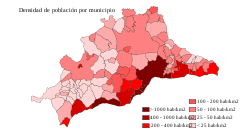
Municipalities of the metropolitan area are connected by the road network (including motorways) with the urban area and Málaga city (the urban area can be reached by car from the farthest reaches in 20 minutes and Málaga city in 45 minutes). In some usages the metropolitan area includes other municipalities to which Málaga's public transport network extends, at least since the establishment of the Consorcio de Transporte Metropolitano del Área de Málaga (en: Consortium of Transportation of Málaga Metropolitan Area). Together about 1.3 million (max. 1.6 million[10]) people live in the Málaga metropolitan area and the number grows every year as all the municipalities and cities of the area record an annual increase in population.
Climate
The climate is subtropical-Mediterranean (Köppen climate classification: Csa)[11] with very mild winters and hot summers. Málaga enjoys plenty of sunshine throughout the year, with an average of about 300 days of sunshine and only about 50 days with precipitation annually. Its coastal location with winds blowing from the Mediterranean Sea make the heat manageable during the summer.[12]
Málaga experiences the warmest winters of any European city with a population over 500,000. The average temperature during the day in the period December through February is 17–18 °C (63–64 °F). During the winter, the Málaga Mountains (Montes de Málaga) block out the cold weather from the north.[12] Generally, the summer season lasts about eight months, from April to November, although in the remaining four months temperatures sometimes reach around 20 °C (68 °F). Its average annual temperature is 23.3 °C (73.9 °F) during the day and 13.7 °C (56.7 °F) at night. In the coldest month, January, the temperature ranges from 13 to 20 °C (55 to 68 °F) during the day, 5 to 13 °C (41 to 55 °F) at night and the average sea temperature is 16–17 °C (61–63 °F). In the warmest month, August, the temperature ranges from 26 to 35 °C (79 to 95 °F) during the day, above 20 °C (68 °F) at night and the average sea temperature is 26 °C (79 °F).
Large fluctuations in temperature are rare. The highest temperature ever recorded during the day at the airport is 44.2 °C (111.6 °F). In the month of August 1881, the average reported daytime maximum temperature was a record 34.8 °C (94.6 °F). The coldest temperature ever recorded was −3.8 °C (25.2 °F) on the night of 4 February 1954.[13] The highest wind speed ever recorded was on 16 July 1980, measuring 119 km/h (73.94 mph). Málaga city has once recorded snow in the 20th century, on 2 February 1954.[14]
Annual average relative humidity is 65%, ranging from 58% in June to 72% in December.[15] Yearly sunshine hours is between 2,800 and 3,000 per year, from 5–6 hours of sunshine / day in December to average 11 hours of sunshine / day in July.[15][16][17] Rain occurs mainly in winter, with summer being generally dry. Málaga is one of the few cities in Europe which are "green" all year round.
| Climate data for Málaga Airport, Spain (1981–2010), Extremes (1920–2010) | |||||||||||||
|---|---|---|---|---|---|---|---|---|---|---|---|---|---|
| Month | Jan | Feb | Mar | Apr | May | Jun | Jul | Aug | Sep | Oct | Nov | Dec | Year |
| Record high °C (°F) | 26.8 (80.2) |
30.0 (86) |
31.4 (88.5) |
33.0 (91.4) |
35.0 (95) |
41.0 (105.8) |
44.2 (111.6) |
44.0 (111.2) |
40.0 (104) |
36.3 (97.3) |
30.4 (86.7) |
24.6 (76.3) |
44.2 (111.6) |
| Average high °C (°F) | 16.8 (62.2) |
17.7 (63.9) |
19.6 (67.3) |
21.4 (70.5) |
24.3 (75.7) |
28.1 (82.6) |
30.5 (86.9) |
30.8 (87.4) |
28.2 (82.8) |
24.1 (75.4) |
20.1 (68.2) |
17.5 (63.5) |
23.3 (73.9) |
| Daily mean °C (°F) | 12.1 (53.8) |
12.9 (55.2) |
14.7 (58.5) |
16.3 (61.3) |
19.3 (66.7) |
23.0 (73.4) |
25.5 (77.9) |
26.0 (78.8) |
23.5 (74.3) |
19.5 (67.1) |
15.7 (60.3) |
13.2 (55.8) |
18.5 (65.3) |
| Average low °C (°F) | 7.4 (45.3) |
8.2 (46.8) |
9.8 (49.6) |
11.1 (52) |
14.2 (57.6) |
18.0 (64.4) |
20.5 (68.9) |
21.1 (70) |
18.8 (65.8) |
15.0 (59) |
11.3 (52.3) |
8.9 (48) |
13.7 (56.7) |
| Record low °C (°F) | −2.6 (27.3) |
−3.8 (25.2) |
−1.2 (29.8) |
2.8 (37) |
5.0 (41) |
9.8 (49.6) |
10.0 (50) |
12.2 (54) |
10.2 (50.4) |
5.6 (42.1) |
1.4 (34.5) |
−0.8 (30.6) |
−3.8 (25.2) |
| Average precipitation mm (inches) | 69 (2.72) |
60 (2.36) |
52 (2.05) |
44 (1.73) |
20 (0.79) |
6 (0.24) |
0 (0) |
6 (0.24) |
20 (0.79) |
57 (2.24) |
101 (3.98) |
100 (3.94) |
534 (21.02) |
| Average precipitation days (≥ 1 mm) | 6 | 5 | 4 | 5 | 3 | 1 | 0 | 1 | 2 | 4 | 6 | 7 | 42 |
| Mean monthly sunshine hours | 181 | 180 | 222 | 244 | 292 | 329 | 347 | 316 | 255 | 215 | 172 | 160 | 2,905 |
| Source: Agencia Estatal de Meteorología[18] Agencia Estatal de Meteorología[15] | |||||||||||||
Main sights

The old historic centre of Málaga reaches the harbour to the south. In the north it is surrounded by mountains, the Montes de Málaga (part of the Baetic Cordillera) lying in the southern base of the Axarquía hills, and two rivers, the Guadalmedina – the historic center is located on its left bank – and the Guadalhorce, which flows west of the city into the Mediterranean.
The oldest architectural remains in the city are the walls of the Phoenician city, which are visible in the cellar of the Museo Picasso Málaga.
The Roman theatre of Málaga, which dates from the 1st century BC, was rediscovered in 1951.[19]
The Moors left posterity the dominating presence of the Castle of Gibralfaro, which is connected to the Alcazaba, the lower fortress and royal residence. Both were built during the Taifa period (11th century) and extended during the Nasrid period (13th and 14th centuries). The Alcazaba stands on a hill within the city. Originally, it defended the city from the incursions of pirates. Later, in the 11th century, it was completely rebuilt by the Hammudid dynasty.[20] Occupying the eastern hillside that rises from the sea and overlooks the city, the Alcazaba was surrounded by palms and pine trees.
Like many of the military fortifications that were constructed in Islamic Spain, the Alcazaba of Málaga featured a quadrangular plan. It was protected by an outer and inner wall, both supported by rectangular towers, between which a covered walkway led up the slope to the Gibralfaro (this was the only exchange between the two sites). Due to its rough and awkward hillside topography, corridors throughout the site provided a means of communications for administrative and defensive operations, also affording privacy to the palatial residential quarters.
The entrance of the complex featured a grand tower that led into a sophisticated double bent entrance. After passing through several gates, open yards with beautiful gardens of pine and eucalyptus trees, and the inner wall through the Puerta de Granada, one finds the 11th- and 14th-century Governor's palace. It was organised around a central rectangular courtyard with a triple-arched gateway and some of the rooms have been preserved to this day. An open 11th-century mirador (belvedere) to the south of this area affords views of the gardens and sea below. Measuring 2.5 square metres (27 square feet), this small structure highlighted scalloped, five-lobed arches. To the north of this area were a waterwheel and a Cyclopean well (penetrating forty metres or 130 feet below ground), a hammam, workshops and the monumental Puerta de la Torre del Homenaje, the northernmost point of the inner walls. Directly beyond was the passage to the Gibralfaro above.

The Church of Santiago (Saint James) is an example of Gothic vernacular Mudéjar, the hybrid style that evolved after the Reconquista incorporating elements from both Christian and Islamic tradition. Also from the period is the Iglesia del Sagrario, which was built on the site of the old mosque immediately after the city fell to Christian troops. It boasts a richly ornamented portal in the Isabeline-Gothic style, unique in the city.
The Cathedral and the Episcopal Palace were planned with Renaissance architectural ideals but there was a shortfall of building funds and they were finished in Baroque style.
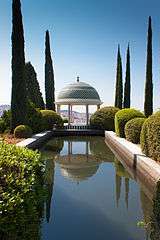
The Basílica y Real Santuario de Santa María de la Victoria, built in the late 17th century, has a chapel in which the vertical volume is filled with elaborate Baroque plasterwork.
Other sights include:
- Walls. Phoenician, Roman, Byzantine, Arab and Spanish remains of the defensive compounds of the city.
- La Concepción, botanical and historical garden.
- Church of the Sacred Heart.
- San Felipe Neri Church.
- Church of the Holy Martyrs.
- Atarazanas Market.
- Palm grove and Muelle Uno. Port of Málaga.
- Anglican Cemetery of St. George.
- San Miguel Cemetery.
- La Malagueta bullring.
- Pedregalejo, old fishing district.
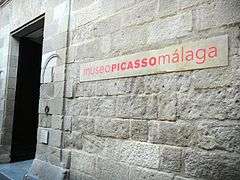
Museums
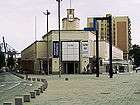
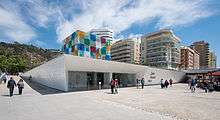
In the early part of the 21st century, the city of Málaga invested heavily (more than 100 million euros in 10 years)[21] in the arts to draw tourists and establish itself as a cultural Andalucia destination with 28 museums.[22] Some notable and recently opened museums are:
- Museo Picasso Málaga, opened in 2003, at the Palacio de los Condes de Buenavista, near the Cathedral.
- Centre Pompidou Málaga, opened in 2015, a branch of the Centre Georges Pompidou in Paris, located in El Cubo, a cuboid glass structure in Málaga port.
- Museo Carmen Thyssen, opened in 2011, sister museum to the Thyssen-Bornemisza Collection in Madrid, located at Palacio de Villalón.
- Museo de Málaga (Fine Arts and Archeology museum) at the Palacio de la Aduana.
- Centro de Arte Contemporáneo de Málaga (CAC Málaga), opened 2003, free admission, right behind the Alameda train station in an area known as Soho de Málaga. The most visited museum in Andalusia.
- Fundación Picasso and Picasso Birthplace Museum.
- Colección del Museo Ruso (Collection of the Russian Museum) Saint Petersburg/Málaga, opened in 2015, located in the Tabacalera building one km west of the city center..
- Museum Jorge Rando, opened in 2015.
- Museo de Artes y Costumbres Populares (Museum of Arts and Popular Traditions).
Demographics

In 2013 there were 568,479 people residing in Málaga.
The number of resident foreign nationals has risen significantly in Málaga since the 1970s, especially of British and German citizens who move for the pleasant climate. The majority of foreigners live near the coastline.[23]
Politics and administration
Málaga is divided in 11 municipal districts.[24]
| Nº | District | Nº | District | Location |
|---|---|---|---|---|
| 1 | Centro | 7 | Carretera de Cádiz | 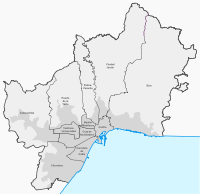 |
| 2 | Este | 8 | Churriana | |
| 3 | Ciudad Jardín | 9 | Campanillas | |
| 4 | Bailén-Miraflores | 10 | Puerto de la Torre | |
| 5 | Palma-Palmilla | 11 | Teatinos-Universidad | |
| 6 | Cruz de Humilladero |
Economy

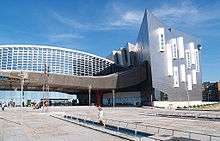
Málaga is the fourth-ranking city in economic activity in Spain behind Madrid, Barcelona and Valencia.[3]
The most important business sectors in Málaga are tourism, construction and technology services, but other sectors such as transportation and logistics are beginning to expand. The Andalusia Technology Park (PTA) (In Spanish, "Parque Tecnológico de Andalucía"), located in Málaga, has enjoyed significant growth since its inauguration in 1992 by the King of Spain. In 2010, this high-tech, science and industrial park was home to 509 companies and employed over 14,500 people.
In line with the city's strategic plan, the campaign "Málaga: Open for Business" is directed towards the international promotion of the city on all levels but fundamentally on a business level. The campaign places a special emphasis on new technologies as well as innovation and research in order to promote the city as a reference and focal point for many global business initiatives and projects.[25]
Málaga is a city of commerce and tourism has been a growing source of revenue, driven by the presence of a major airport, the improvement of communications, and new infrastructure such as the AVE and the maritime station, and new cultural facilities such as the Picasso Museum, the Contemporary Art Centre and Trade Fair and Congress, which have drawn more tourists.[26]
The city hosts the International Association of Science and Technology Parks (IASP) (Asociación Internacional de Parques Tecnológicos), and a group of IT company executives and business leaders has launched an information sector initiative, Málaga Valley e-27, which seeks to make Málaga the Silicon Valley of Europe. Málaga has had strong growth in new technology industries, mainly located in the Technological Park of Andalusia, and in the construction sector. The city is home to the largest bank in Andalusia, Unicaja, and such local companies as Mayoral, Charanga, Sando, Vera, Ubago, Isofoton, Tedial, Novasoft, Grupo Vértice and Almeida viajes, and other multinationals such as Fujitsu Spain, Pernod Ricard Spain, Accenture, Epcos, Oracle Corporation, Huawei and San Miguel.[27] Nobel prize-winner Bruce Beutler is planning to set up the biggest mutagenesis research laboratory in the world in Malaga.[28]
| Industrial sector | Companies |
| Energy and water | 24 |
| Chemical and mining | 231 |
| Mechanical engineering industry | 833 |
| Manufacturing | 1,485 |
| Total | 2,573 |
| Industrial activity index | 771 |
| Construction-related companies | 3,143 |
Culture
Annual cultural events

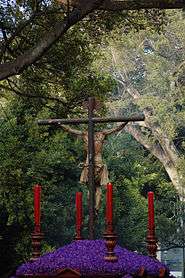
The Holy Week celebration, the August Málaga Fair (Feria de Málaga) and the Málaga Film Festival are the three major events held in the city.
The Holy Week has been observed for five centuries in Málaga. Processions start on Palm Sunday and continue until Easter Sunday. Images depicting scenes from the Passion are displayed on huge ornate tronos (floats or thrones), some weighing more than 5,000 kilograms (11,000 pounds). Famous is the royal archbrotherhood of Our-Lady of Hope Nuestra Señora de la Esperanza. They have more than 5,000 members and 600 nazarenos. These tronos highlight the processions that go through the streets led by penitents dressed in long robes, with capirote, followed by women in black carrying candles. Drums and trumpets play music and occasionally someone spontaneously sings a mournful saeta dedicated to the floats as they make their way slowly round the streets. Some Holy Week tronos are so huge that they must be housed in places outside the churches, as they are taller than the entrance doors. Famous is the military procession of "la legion" (Royal congregation of Mena) playing marches and singing their anthem (El Novio de la Muerte) during procession.
During the celebration of the Feria de Málaga in August, the streets are transformed into traditional symbols of Spanish culture and history, with sweet wine, tapas, and live flamenco shows. The day events consist of dancing, live music (like Flamenco or Verdiales, traditional music from Málaga) and bullfights at La Malagueta, while the night fair is moved to the Recinto Ferial, consisting of restaurants, clubs, and an entire fair ground with rides and games.
The Málaga Film Festival (Festival de Málaga Cine Español (FMCE)), dedicated exclusively to films produced in Spain, is one of the most important festivals in the country. It is held annually during a week in March or April.
Religion
Most of the population of Málaga professes Roman Catholicism as its religion. Protestants also have a presence in Málaga: one of seven congregations of the Reformed Churches in Spain is based in the city and is the only one that permits paedocommunion, while The Church of Jesus Christ of Latter-day Saints is growing.
Islam is represented by a growing number of immigrants and a mosque, while the Jewish community (primarily Sephardi) is represented by its synagogue and the Jewish Association.
Sports
.jpg)
Málaga is home to three major professional sports teams. These include:
- Málaga CF – football club plays in Primera División. Honours: UEFA Intertoto Cup: 2002, UEFA Cup: 2003 (Quarter-finals), UEFA Champions League: 2013 (Quarter-finals).
- CB Málaga – basketball club plays in ACB League. Honours: Spanish Championship: 2006, runner-up: 1995, 2002; Spanish Cup: 2005, runner-up: 2009; Spanish Super-Cup: runner-up: 2006, 2015; Korać Cup: 2001, runner-up: 2000; Euroleague: third place: 2007
- CD El Palo – football club plays in third level of Spanish football: Segunda Division B
- Club Atlético Málaga – women's football club plays in Superliga Femenina, Honours: Spain Cup: 1998, runner-up: 1997; Spain Supercup: 1999
The city has four large sports facilities:
- Estadio La Rosaleda – football stadium, with a capacity of 30,044. One of the arenas of Primera División (for Málaga CF) and 1982 FIFA World Cup. Final of UEFA Intertoto Cup 2002.
- Jose Maria Martin Carpena Arena – sports arena, with a maximum capacity of 14,000. It is home of CB Málaga and arena of Spanish Cup 2001, 2007, 2014; Spanish Super-Cup 2004, 2006, 2015; NBA Europe Live Tour 2007;
- Estadio de Atletismo Ciudad de Málaga – athletics stadium with a capacity of 7,500. Place where the European Cup 2006 was celebrated; 2006 Vuelta a España; Spain Athletics Championships 2005 and 2011;
- Centro Acuático de Málaga (Málaga Aquatic Centre) – water arena, with a capacity of 17,000. Arena of European Water Polo Championship 2008.
In city and neighbourhood, you can engage in many sports, for example: surfing, windsurfing, kitesurfing, swimming, diving, skydiving, paragliding, running, cycling, rowing, tennis and golf.
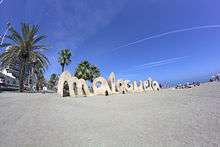
The city will host the 21st World Transplant Games from 25 June to 2 July 2017 [30]
Tourism
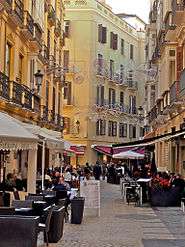
The city is an important tourist destination, known as "the capital of the Costa del Sol". An estimated 6 million tourists visit the city each year.[31] Tourists usually visit the birthplace of Pablo Picasso and the Museo Picasso Málaga, the Carmen Thyssen Museum, the old town or the beaches. The Málaga harbour is also the second busiest cruise port of the Iberian Peninsula.
A popular walk leads up the hill to the Gibralfaro castle (a Parador), offering panoramic views over the city. The castle is next to the Alcazaba, the old Muslim palace, which in turn is next to the inner city of Málaga. Other nearby attractions are the Roman Theatre, the old Jewish quarter, the Cathedral, and the Church of Santiago in mudéjar style. A popular walk follows the Paseo del Parque (a promenade that runs alongside a grand park with many palm trees and statues) to the harbour, ending in Calle Larios, the main commercial street of the city. There is also a curious museum, the Museum of the Holy Week, which includes an impressive display of Baroque ecclesiastical items.
Other events
The Fiesta Mayor de Verdiales takes place every year on 28 December during which Spain's April Fool Day is celebrated.[32]
The Fiestas de Carnaval, in which people dress in all types of costumes, takes place prior to the holy 40 days of Lent every February. A contest is held in the Teatro Cervantes between groups of singers, quartets and choirs who compete in the singing of ironic songs about social and political issues. The Carnival takes to the streets of Málaga on the week before Ash Wednesday, ending on Malagueta beach with the burial of the anchovy (entierro de la sardina).[32]
Education
International schools in Málaga city:
- Lycée Français de Málaga (French school)
- St. George´s School, Málaga (British school)
Transport
Airport

The city is served by Málaga Costa Del Sol Airport, one of the first in Spain and the oldest still in operation. In 2008, it handled 12,813,472 passengers,[33] making it the fourth-busiest in Spain. It is the international airport of Andalusia, accounting for 85 percent of its international traffic. The airport, connected to the Costa del Sol, has a daily link with twenty cities in Spain and over a hundred cities in Europe (mainly in United Kingdom, Central Europe and the Nordic countries but also the main cities of Eastern Europe: Moscow, Saint Petersburg, Budapest, Sofia, Warsaw, Riga or Bucharest), North Africa, Middle East (Riyadh, Jeddah and Kuwait) and North America (New York City, Toronto and Montreal).
The airport is connected to Málaga City and surrounding areas through a transport hub, which includes the bus system and suburban trains[34][35] and car parks.
Seaport
.jpg)
The Port of Málaga is the city's seaport, operating continuously at least since 600 BC. The port is one of the busiest ports on the Mediterranean Sea, with a trade volume of over 428,623 TEU and 642,529 passenger in 2008.[36]
High-speed train
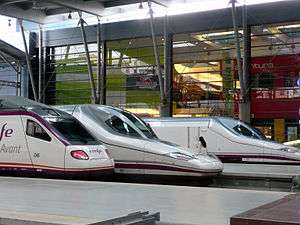
The Málaga María Zambrano railway station is served by the AVE high-speed rail system, and is operated by the Spanish formerly state-owned rail company Renfe. Málaga is on the AVE experience, a net created with Málaga next to 17 major cities of Spain with high-speed rail.
Roads and highways
The A45 road leads north to Antequera and Córdoba. The Autovía A-7 parallels the N-340 road, both leading to Cádiz to the west through the Costa del Sol Occidental and Barcelona to the east through the Costa del Sol Oriental.
Urban bus
Empresa Malagueña de Transportes[37] buses are the main form of transport around the city.[38] Málaga's bus station is connected with the city by the bus line number 4, although it is only ten minutes' walk to the Alameda from there.
Metropolitan bus
Málaga Metropolitan Transport Consortium's (Consorcio de Transporte Metropolitano del Área de Málaga)[39] buses are the main form of transport around the city of Málaga and the villages of the Metropolitan Area.
Mass transit
The city has two commuter train lines Cercanías and a light rail system.[40]
Notable people
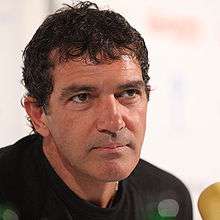

- Solomon ibn Gabirol (1021–1058), philosopher and poet
- Ibn al-Baitar (1188–1248), botanist and pharmacist
- Ruy López de Villalobos (1500–1544), explorer
- Diego de Montemayor (1530–1611), founder of Monterrey, Mexico and governor of Nuevo León
- Francisco de Leiva (1630–1676), playwright
- Luis de Unzaga (1721–1790), politician
- Bernardo de Gálvez (1746–1786), Count of Gálvez and Viscount of Galveston, military and colonial administrator
- María Manuela Kirkpatrick (1794–1879), aristocrat
- José de Salamanca (1811–1883), Marquis of Salamanca and Count of Los Llanos, businessman and politician
- Antonio Cánovas del Castillo (1828–1897), Prime Minister of Alfonso XII
- José Denis Belgrano (1844–1917), painter
- José Moreno Carbonero (1858–1942), painter
- Pablo Picasso (1881–1973), artist
- José Moreno Villa (1887–1955), painter and writer
- Bernardo Giner de los Ríos (1888–1970), architect and politician
- Victoria Kent (1898–1987), lawyer and politician
- Luis Bolín (1894–1969), lawyer and journalist
- Emilio Prados (1899–1962), poet
- Manuel Altolaguirre (1905–1959), poet
- Antonio Molina (1928–1992), singer
- Antonio Luque (1941–), engineer and photovoltaics pioneer
- Juan Madrid (1943–), writer and journalist
- Marisol (1948–), singer and actress
- Amparo Muñoz (1954–2011), Miss Universe Spain 1974, Miss Universe 1974
- Jorge Rando (1941–), artist
- Antonio Banderas (1960–), actor
- Miguel Ángel Jiménez (1964–), professional golfer
- Carlos Álvarez (1966–), baritone
- Antonio de la Torre (1968–), actor
- María del Mar Rodríguez Carnero, La Mari (1975–), singer
- Juan García Postigo (1981–), Mister World 2007
- Ana López Rodríguez, Anni B Sweet (1987–), singer
- Pablo Alborán (1989–), singer
- Joe Atlan (1989–), musician
- Isco Alarcón (1992–), footballer
- Millie Bobby Brown (2004–), actress
- Miguel de Miguel (1975-), actor
Twin towns – Sister cities
See also
References
- ↑ Aubet, María Eugenia.The Phoenicians and the West: politics, colonies and trade. Cambridge University Press. Archived 23 June 2016 at the Wayback Machine.
- 1 2 3 https://www.boe.es/boe/dias/2015/12/17/pdfs/BOE-A-2015-13745.pdf
- 1 2 "LaCaixa Bank economic report, 2011 (spanish)".
- ↑ Leucona, Emilio. «Jornadas de estudio por el 150 aniversario del hallazgo de la Lex Flavia Malacitana». Consulted on 7 April 2008.
- ↑ "Ibn Battuta: Travels in Asia and Africa". Fordham.edu. 21 February 2001. Retrieved 8 April 2011.
- ↑ de Madariaga, Salvador (1952). La vida del muy magnífico señor Don Cristóbal Colón (in Spanish) (5th ed.). Mexico: Editorial Hermes. p. 222.
Málaga, ciudad que acabara de tomar a los moros (18 de agosto)
- ↑ Blood and Faith: The Purging of Muslim Spain, Matthew Carr, page 7, 2009
- ↑ Balfour, Sebastian; Preston, Paul (2009). Spain and the great powers in the twentieth century. London, UK; New York, USA: Routledge. p. 172. ISBN 978-0-415-18078-8.
- ↑ Antony Beevor, The Battle for Spain: The Spanish Civil War 1936–1939. London: Weidenfield and Nicolson. 2006, ISBN 0-297-84832-1
- ↑ "Population by sex and age groups" Archived 22 August 2016 at the Wayback Machine. – Eurostat, 2015
- ↑ "World Map of Köppen−Geiger Climate Classification".
- 1 2 "Málaga City – Local Travel Information and City Guide". Malaga.com. Retrieved 8 April 2011.
- ↑ "Valores extremos de Málaga Aeropuerto".
- ↑ "La gran nevada de 1954". Retrieved 20 June 2012.
- 1 2 3 "Valores Climatológicos Normales. Málaga / Aeropuerto".
- ↑ "Climatological Information for Málaga, Spain" Archived 4 March 2016 at the Wayback Machine. – Hong Kong Observatory
- ↑ "Málaga Climate, Temperature, Average Weather History, Rainfall/ Precipitation, Sunshine". climatetemp.info. Retrieved 8 April 2011.
- ↑ "Valores extremos. Málaga Aeropuerto". Retrieved July 2014. Check date values in:
|access-date=(help) - ↑ "Archived copy". Archived from the original on 23 June 2015. Retrieved 2015-04-12.
- ↑ Dialnet.es, Fanny de Carranza Sell, La alcazaba de Málaga. Historia a través de su imagen, 2011. Archived 10 April 2016 at the Wayback Machine. (In Spanish)
- ↑ "City of museums: Málaga bets on culture to draw tourists and talent". theguardian.com. Retrieved 19 June 2016.
- ↑ "Malaga City – Museums". andalucia.com. Retrieved 19 June 2016.
- ↑ "Málaga Population Information". Malaga.com. Retrieved 8 April 2011.
- ↑ "Districts" (Ayuntamiento de Málaga ed.). Archived from the original on 2 April 2015. Retrieved 31 December 2011.
- ↑ "Málaga calls on the doors of the Anglo-saxon business world". Laopiniondemalaga.es. Retrieved 8 April 2011.
- ↑ Málaga Horizonte 2012 – SOPDE
- ↑ Empresas en el PTA Archived 4 March 2016 at the Wayback Machine. – Parque Tecnológico de Andalucía
- ↑ "Málaga compite con Dallas y Shanghai en acoger un laboratorio de investigación genética" (in Spanish). 23 September 2016. Retrieved 18 October 2016.
- ↑ Anuario Económico de España 2008 La Caixa (Málaga) – La Caixa
- ↑ http://wtgf.org/2017-summer-wtg-malaga/
- ↑ "Málaga City Information". Malaga.com. Retrieved 8 April 2011.
- 1 2 "Málaga Festivals". Malaga.com. Retrieved 8 April 2011.
- ↑ AENA passenger and aircraft movements for 2008
- ↑ Málaga airport
- ↑ "Travelling From Malaga Airport AGP". Dragon Cars. Retrieved 12 June 2013.
- ↑ Memoria 2008, Annual Report, Port of Málaga site
- ↑ "EMT Málaga". Emtmalaga.es. Retrieved 26 March 2013.
- ↑ es:EMT Málaga
- ↑ http://www.ctmam.es Málaga Metropolitan Transport Consortium
- ↑ http://www.telegraph.co.uk/news/worldnews/europe/spain/11003131/Better-late-than-never-Malaga-inaugurates-new-metro.html
- 1 2 3 4 5 "Relaciones Institucionales Internacionales: Ciudades hermanadas" (official website) (in Spanish). Málaga, Spain: Ayuntamiento de Málaga. Retrieved 2015-02-04.
- ↑ "Geminações de Cidades e Vilas". Associação Nacional de Municípios Portugueses (in Portuguese). Retrieved 2013-07-20.
- ↑ "About Manila: Sister Cities". City of Manila. Retrieved 24 November 2016.
- ↑ http://www.malagactiva.es/pdf/exposiciones/De_Puentes_y_Agua.pdf
- ↑ http://www.femp.es/files/566-1112-archivo/LISTADO%20DE%20HERMANAMIENTOS%20CON%20LATINOAM%C3%89RICA.pdf
Sources
- The Alhambra from the Ninth Century to Yusuf I (1354). vol. 1. Saqi Books, 1997.
- Guia Viva, Andalucia, Anaya Touring Club, April 2001.
 This article incorporates text from a publication now in the public domain: Herbermann, Charles, ed. (1913). "article name needed". Catholic Encyclopedia. New York: Robert Appleton.
This article incorporates text from a publication now in the public domain: Herbermann, Charles, ed. (1913). "article name needed". Catholic Encyclopedia. New York: Robert Appleton.
External links
 Málaga travel guide from Wikivoyage
Málaga travel guide from Wikivoyage


